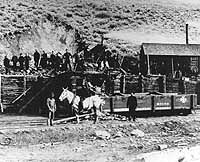| Horses transporting coal cars from mine to tipple. |
Technology has a way of dramatically changing industry and mining for coal is a perfect example of how methods are advanced. One area that has seen a variety of changes over the past century is transportation as it relates to carrying coal. Of all the technical advancements made in the coal industry few are as varied as the methods miners used to get the coal to market.
Although there are numerous miners who have seen first hand the changes Jack Pressett, formerly manager of the Columbia Mine near East Carbon, provided the pictures of the various modes of transportation and explained how each phase advanced. Within 100 years coal mining literally advanced from using dogs to carry our small carts of coal to transporting hundreds of thousands of tons of coal over the mountain pass several times a day.
In the history of coal mining, the dog was used and a small cart carried very little coal, possibly 100 pounds out of the mine shafts. Pressett estimates that the dog was used up to about 75 years ago.
Next came the mule and horse, who were able to pull a much larger load, possibly up to a ton. Then, with the advancement of electricity, electric motors were able to pull 50 coal cars loaded with 10 tons of coal. Time frame for this method was in the early 1920’s. These had no brakes and no rotation.
Finally, with the development of the conveyor belt and shuttle car, coal was transported to an electrical plant by railroad locomotives in the amounts of over 10,000 tons. Miners didn’t have to unlock the cars because of a “kickback” turn car that pivoted the cars around to load and unload the coal.
In modern days, transportation includes a 100 railroad cars, each with 100 ton of coal, carrying coal to distribution sites.
Pressett said this was a vast improvement in transportation and production. In an industry that is the primary producer of electricity it took production to a whole new level.
Small towns, big hearts
Citizens of smaller communities may earn less money than their counterparts in the big city, but they are rich when it comes to the spirit of giving.
A recent study suggests that Utah residents living in counties outside of the Salt Lake metropolitan area typically give a higher percentage of their discretionary income to charities. The findings were produced by the Chronicle of Philanthropy, a publication dedicated to news and events surrounding philanthropic activities.
The data covers taxpayers who earned $50,000 or more and itemized their returns. To determine discretionary income, the Chronicle accounted for housing and food costs, taxes, and other basic living expenses.
Despite Salt Lake City’s ranking as the number one metropolitan area in the U.S. when it comes to charity giving, Salt Lake County ranked 21st out of 29 counties in Utah. In. Emery County, where residents are typically earning less than those in Salt Lake County, people are donating an average of 19 percent of their discretionary income to charities-5 percent more than their big city counterparts.
“I think it illustrates the generosity and compassion of people who live in our communities,” said Greg Killpack, CEO and general manager of Emery Telcom.
Emery Telcom, a small, local telecommunications provider, donated more than $20,000 dollars to local schools, communities and charities in 2003. Killpack points out, the year is not over and that more needs to be done.
This is just one of many examples where businesses, individuals and organizations in smaller communities are continuing to promote good causes. And that’s good news for charities following a difficult year for fundraising. According to the Chronicle, charitable contributions nationwide experienced a decline for the first time since 1990. It states that donations across the country during 2002 declined 1.2 percent, after adjusting for inflation-a dramatic difference compared to the five preceding years when the average annual gain was 12 percent. Aggregate donations among the groups in this year’s survey totaled $46.9 billion, down from $47.5 billion last year. The report notes economic uncertainty among donors, as having contributed to the decline.
But even as big corporations tighten their belts and shrink their philanthropic budgets, charities continue to muster up the grassroots support found in small communities.
Dori Kelch, the area director for the Southeastern Utah District of the American Cancer Society said, “If not for the incredible generosity of each individual in our community we could not support our life-saving mission.”

